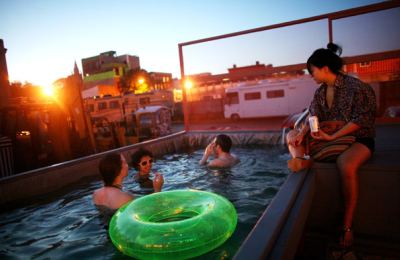Late of Seattle, Fionn Meade will be in charge of the lineup at the Sculpture Center. A video installation by Meade and his wife, the artist Mary Simpson, titled Young Americans, is at the Seattle Art Museum through Aug. 30. Podcast interview with Meade and Simpson here. Their Web site here.
Archives for July 2009
Wednesday links
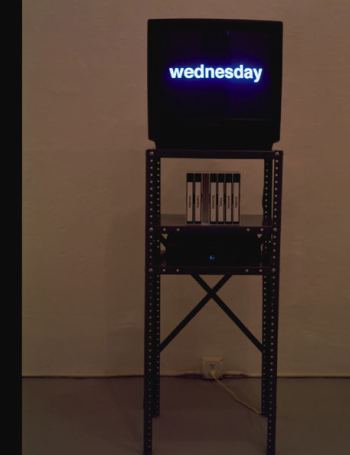
Only thing wrong with this story: It isn’t true. BRAVO’s Untitled Art Project did not add auditions in Seattle, Boston, San Francisco and Dallas.
Richard Lacayo on the addictive quality of watching live coverage of the 4th Plinth:
Thirty five years ago Chris Burden put himself on a platform in a New York gallery for 22 days. But since Burden was an artist, that made what he did “art” in a more — is the word here “official”? — way. Gormley has democratized Burden’s work by letting anybody perform it, which of course is what all of us are doing all day anyway. I’m existing right now, and I’m not even on a pedestal.
More Lacayo here. Seattle’s piece of the Plinth here.
Latest threat to Spiral Jetty here.
How did I miss this? Libby Rosof calls Jeffry Mitchell’s contributions to Dirt on Delight from the ICA (now at the Walker) the “Versailles of pickle jars.” Mitchell is currently at James Harris Gallery. Review soon. Jen Graves on Mitchell here.
SuttonBeresCuller – gas(less) station as sculpture
Last Saturday night, the Seattle artist team of John Sutton, Ben Beres and Zack Culler celebrated their ability to keep on keeping on through a morass of ecological setbacks and bureaucratic hurtles by throwing themselves a small party at their site.
The party had to be small, because they have no right to occupy the premises on which they pay rent. Nobody has occupancy rights, not even the owner. The EPA doesn’t want people to hang around unless they’re in hasmat suits.
Dealing with the EPA was never part of their plan. Their original idea was to create a mini-park/sculpture on the Monorail Line, but when voters said no to expanding the line in 2005, the idea lost its base. Not for long. Four years ago, they rented an abandoned gas station on the corner of Warsaw and Ellis, between Boeing Field and the Duwamish River, one of the most contaminated in the country.
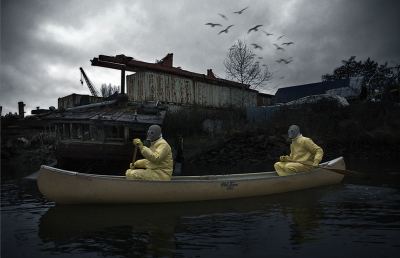 Before renting to them, the owner showed them a 1980s clean bill of health from the EPA, which, as it turns out, means little. Because the station had been vacant for three years, another inspection was required.
Before renting to them, the owner showed them a 1980s clean bill of health from the EPA, which, as it turns out, means little. Because the station had been vacant for three years, another inspection was required.
“The ’80s were the dark ages of environmental cleanup,” said Ben Beres. “They’d dig a hole and sniff. This place wasn’t soil tested.”
Tests revealed more than the localized gas pump pollution the trio expected. Instead, 12 feet under the soil is a free-ranging plume of contaminants. Instead of the usual clump-and-treat method, the brown field they’ve been happy to call a home away from home requires a far more complex intervention.
Walk away, friends said. SuttonBeresCuller are not environmental artists. They’re performance artists who make things. They have no manifesto to consult or burning desire to save the earth. Till now. They want to turn a ruined mess into a pocket park, public sculpture, experimental exhibition space and environmental remediation project and leave it as a gift to the South Park/Georgetown communities.
 The hunt continues for funding and permission from a web of agencies. Creative Capital gave them $50,000 in 2005, and 4Culture just wrote a check for an Arts Cultural Facilities Award of $68,000. After the cleanup, they’re going to bury the back of the station underneath a grassy knoll and light the park with solar panels.
The hunt continues for funding and permission from a web of agencies. Creative Capital gave them $50,000 in 2005, and 4Culture just wrote a check for an Arts Cultural Facilities Award of $68,000. After the cleanup, they’re going to bury the back of the station underneath a grassy knoll and light the park with solar panels.
When do they think it will happen?
“2010,” said Sutton. That would be a small miracle. Brendan Kiley’s story here.
Alfred Leslie and Virginia Wright – the meaning of red
In 1974-75, Alfred Leslie painted Virginia Wright, as part of his Red Painting Series. (Who she is here.)
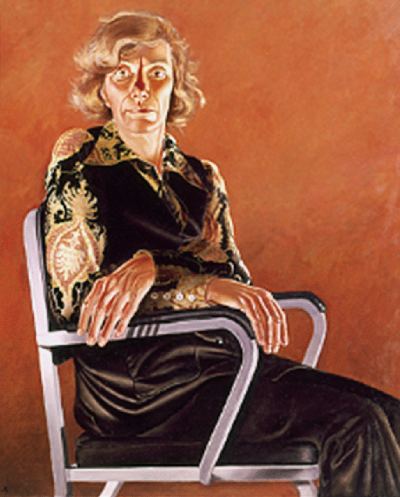 The color can’t be said to describe her politics, which tend to be casually, even indifferently, Republican. She broke with the party in the early 1990s over the Culture Wars and their impact on the NEA. (Story here.) Her husband Bagley waited till 2004 to follow her lead, reasoning that the world couldn’t take four more years of George Bush.
The color can’t be said to describe her politics, which tend to be casually, even indifferently, Republican. She broke with the party in the early 1990s over the Culture Wars and their impact on the NEA. (Story here.) Her husband Bagley waited till 2004 to follow her lead, reasoning that the world couldn’t take four more years of George Bush.
Leslie painted Virginia Wright as if she were decades older than she was at the time. In his version, she might be a loose-limbed forest ranger with big bones and no make up, instead of the petite, urban and immaculately groomed woman she continues to be.
He was after the intensity of her character informed by her interest in art, which colors everything about her. Her daughter Merrill Wright once said that her mother had five children, the four of record and the fifth being art. Everybody thought she loved the fifth child best.
Operating in the tradition of Thomas Eakins, not John Singer Sargent, going for the specific, not the general, Leslie is true to his version of the facts. As he says:
You can’t alter facts by filming them over with dead romances.
And
Some circumstantial evidence is very strong, as when you find a trout in the milk.
Leslie has a terrific Web site for his books of images (and some text), a few of which can be viewed in their entirety online.
Jesse Edwards in a dark suit talks to the NYT
In Randy Kennedy’s NTY story about artists trying out for BRAVO’s yet unnamed reality show, he featured Jesse Edwards, late of Seattle and now, wrote Kennedy, living “hand to mouth” in New York, the only artist quoted at length and the only one identified in a photo caption.
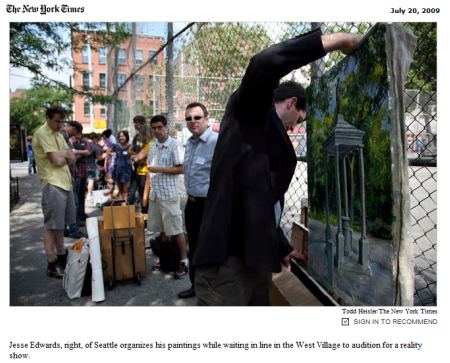 He looks somebody invented by Flannery O’Connor, maybe the hero in The Violent Bear It Away. It’s hot in New York in July, but if an artist is going to stand out, he might as well do it in a dark suit. Behind him, pikers look as if they’re waiting for the bus.
He looks somebody invented by Flannery O’Connor, maybe the hero in The Violent Bear It Away. It’s hot in New York in July, but if an artist is going to stand out, he might as well do it in a dark suit. Behind him, pikers look as if they’re waiting for the bus.
Here’s Edwards’ piece of the story:
About a third of the way back in the line, Jesse Edwards, a 31-year-old painter and ceramics artist from Seattle who has been living hand to mouth since moving to New York this summer, opened his portfolio to show a picture of a work that the producers might keep handy as a cautionary reminder: a ceramic television with an image of painted apples as its screen. The piece was titled “Still Life Channel.”
“It’s a snoozer of a channel, the Still Life Channel,” Mr. Edwards said, but then quickly showed a picture of another ceramic television, this one with a mirror as its screen, titled “Your Personal Moment of Fame.”
I wonder if he brought his bong.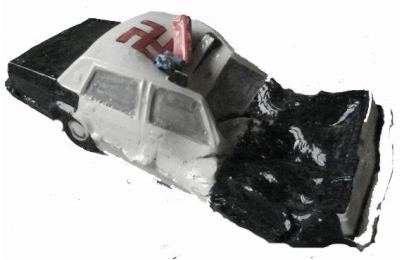 I hope he brought a couple of portraits.
I hope he brought a couple of portraits.
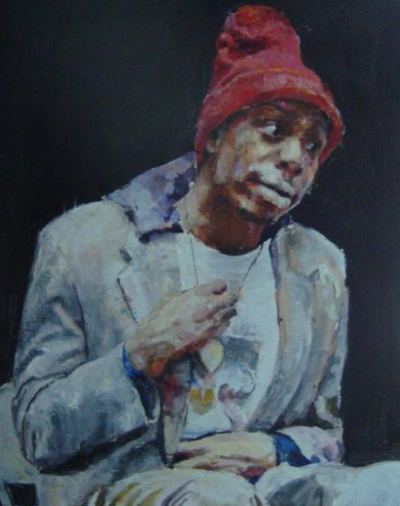
Good luck, Jesse.
Gatsby’s green light as an inner tube
Gatsby believed in the green light, the orgiastic future that year by year recedes before us. It eluded us then, but that’s no matter — tomorrow we will run faster, stretch out our arms farther. . . And then one fine morning —
So we beat on, boats against the current, borne back ceaselessly into the past.
The new version of the green light: Yana Paskova photo in the New York Times, accompanying a story about using a dumpster as a hot tub.
Free floating on the Internet, via Nathan Lippens:
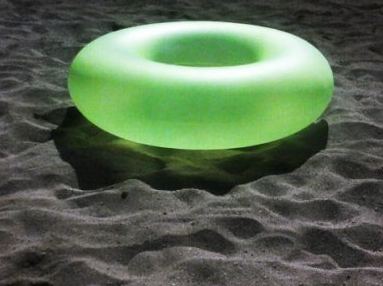
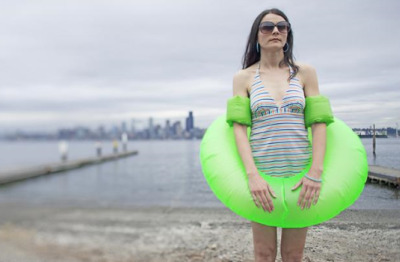
Blowing the artist’s statement
It is a truth universally acknowledged, that an artist in possession of a gallery must be in want of an artist statement.
Will this do?
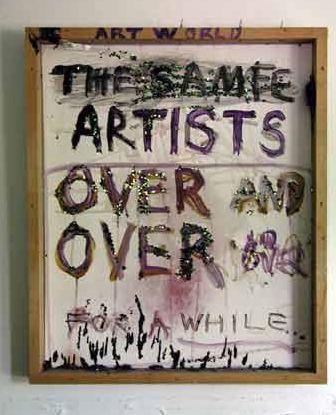 Ben Beres took another option, going on and on: Artist’s Statement, Etching, relief roll, chine colle.12 x 9 inches.
Ben Beres took another option, going on and on: Artist’s Statement, Etching, relief roll, chine colle.12 x 9 inches.
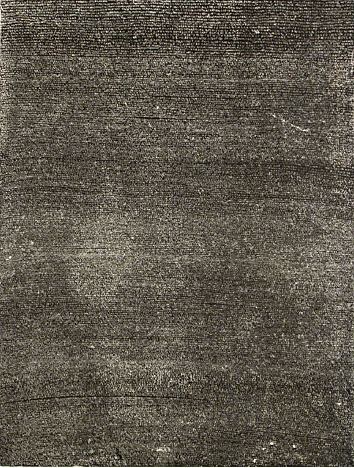 Detail:
Detail: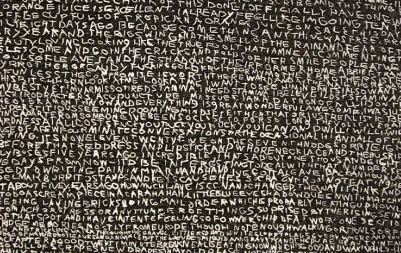
Wave Books: the poetry imperative at the Henry Art Gallery (what Wave is, what it isn’t)
If Frank O’Hara were alive, chances are he’d be published at Wave Books, founded in Seattle four years ago by Charles Wright, former director of the Dia.
Wave
specializes in poetry that can be mistaken for conversation but cannot
be entered by a conversationalist. Wave poetry isn’t as consumer
surreal as John Ashbery, as lyrical as Charles Wright (no relation to the publisher), as war-haunted as Charles Simic or as romantically charged as Olga Broumas.
Wave
poets are not in love with bars and do not want to be fish leaping in a
river. They do not believe alcoholism will make them better poets. (See
John Berryman and the Booze Talking.)
With the exception of Franck Andre Jamme,
who turns the recognizable into the indecipherable and forces an
admiration for clumped lettering, Wave poets are not islands. The
celebrate (or at least endure) entangling alliances. They burrow. They
grip down on a person, place or thing and take it for an interior ride.
Many
are unreliable narrators. They mock their own pleasures and confess to
crimes committed by others. They are serious and/or comic, occasionally honest but seldom sincere. They care about art without saying its name.
Sex is graphic but fails to enthrall over the long haul. Even when
reporting from the middle of a forest, they tend to be urban.
Unlike Rita Dove,
they can’t dance, but they refuse to cry a river about it. They are
adults: Their childhoods interest them less than their children’s
childhoods. They crack wise about their political concerns, which are
seen aslant. None is likely to proceed, as Denise Levertov did, from a gnawed-on
dead squirrel in wet grass to urgent, anti-war narratives.
Frank McCourt – cancer is a disease you can’t walk away from
When I interviewed Frank McCourt and Mary Gordon in Seattle in 1998, he took issue with the idea that alcoholism is a disease.
Cancer is a disease. You can walk away from the bottle. A disease is something you can’t walk away from.
He died today at 78 of metastatic melanoma.
Here’s the interview:
Neither Frank McCourt nor Mary Gordon had childhoods anybody would envy, but as McCourt points out, “the happy childhood is hardly worth your while.”
The pair of New Yorkers shared the stage last night as part of the Seattle Arts & Lectures series at the Fifth Avenue Theatre.The reasoning behind their joint appearance is obvious: Both have written acclaimed memoirs published addressing the travails of Irish Catholic upbringings.
In Gordon’s The Shadow Man, she writes of her Jewish father who converted to Catholicism and became rabidly anti-Semitic. He died when she was 7, leaving her in the care of largely Irish Catholic relatives who were suspicious of her dark good looks and ready to criticize any evidence of “the Jew” in her.
“Mary’s book is about mental and spiritual suffering,” McCourt said. “My suffering was monetary. We were lacking for food, shelter and clothing. If I was particularly demanding as a child, my mother would say, `The next thing you’ll be wanting is an egg,’ as if it were a golden chalice.”
[Read more…] about Frank McCourt – cancer is a disease you can’t walk away from
Merrill Wagner – the astringent flourish
For more than three decades, Merrill Wagner has tracked the transmutation of form and the shifting vagaries of tone. She has incised lines of color into fragments of marble and let them
erode, and she has painted rectangular bands across steel panels
already marked by the erosions of rust and industrial sanding.
She tends to participate in her own aesthetic process instead of commanding it, but not, apparently, when making flowers.
Below, Thistle, rust preventative paint on steel, 90 x 47 inches. Individual pieces held in place on the wall with magnets.
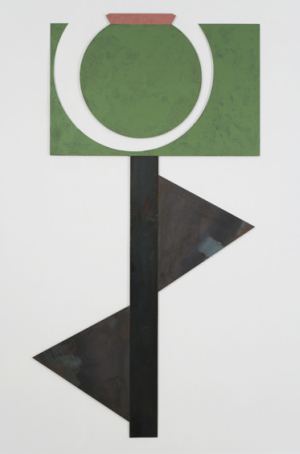
Wagner likes to improvise with nature and also with the work of other artists, which in her hands becomes a kind of nature.
Two brands of Naples Yellow on Marble (8 by 11.5 inches) is an answer to similar work by Brice Marden, located somewhere between Marden’s magisterial marks and accident.
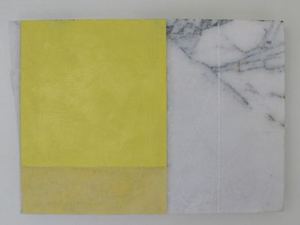
Her Northern (33 x 96 inches) could have been titled, Milton Avery in a steelyard.
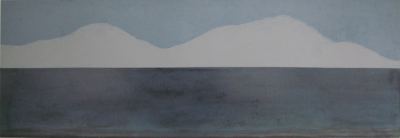
Her Envelope (66 x 96 inches) looks like Christopher Wilmarth, had he lived long enough to forsake glass and discover color.
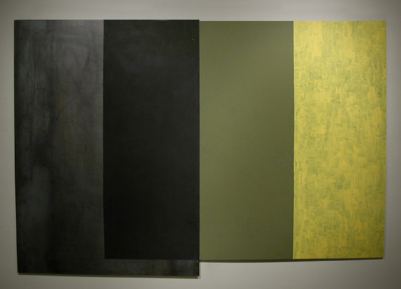
Instead of being imitative, her aesthetic is communal in nature and yet steadfast to its purpose. I don’t know if an exhibit devoted to Wagner and her family has occurred, but if it does, I’d like to see it. She’s married to Robert Ryman, and the work of both their sons (Cordy and Will Ryman) is rounding the curve and coming on strong in the stretch.
Wagner is at Traver though Aug. 2.



